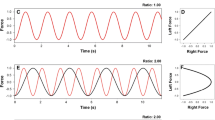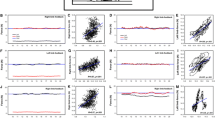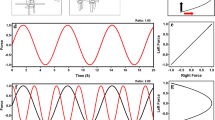Abstract
Increases in the oscillation frequency of bimanual movements produce a switch from an anti-phase (180° relative phase) to an in-phase (0° relative phase) coordination pattern. This finding is observed when subjects are instructed not to intervene when they feel themselves slipping out of the anti-phase pattern. The question addressed in this study concerned how performance would be affected if subjects were instructed to try to maintain the pattern at all times. This issue was addressed using two separate groups of subjects: one group was given the “do not intervene” instructions, the other group was told to try to stay with the pattern at all times. Forearm rotations were tested in 15 s trials, paced by an auditory metronome set at 1.0, 1.5, 2.0, 2.5, and 3.0 Hz. Frequency distributions of the point estimates of relative phase were analyzed. The Do not Intervene group replicated previous findings, as indicated by the development of a bimodal histogram of relative phase distributions with increases in oscillation frequency. However, a very different pattern of findings emerged with increases in oscillation frequency for the group told to stay with the anti-phase pattern. Rather than a bimodal distribution being developed, the data maintained 180° as its central tendency — no secondary distribution developed around 0° relative phase. These data suggest that volitional control can over-ride the inherent dynamical tendencies of the motor system.
Similar content being viewed by others
References
Baldissera, F., Cavallari, P., & Civaschi, P. (1982). Preferential coupling between voluntary movements of ipsilateral limbs.Neuroscience Letters, 34, 95–100.
Baldissera, F., Cavallari, P., Marini, G., & Tassone, G. (1991). Differential control of in-phase and anti-phase coupling of rhythmic movements of ipsilateral hand and foot.Experimental Brain Research, 83, 375–380.
Buchanan, J. J., & Kelso, J. A. S. (1993). Posturally induced transitions in rhythmic multijoint limb movements.Experimental Brain Research, 94, 131–142.
Byblow, W. D., & Goodman, D. (1994). Performance asymmetries in multifrequency coordination.Human Movement Science, 13, 147–174.
Byblow, W. D., Carson, R. G., & Goodman, D. (1994). Expressions of asymmetries and anchoring in bimanual coordination.Human Movement Science, 13, 3–28.
Cohen, L. (1971). Synchronous bimanual movements performed by the homologous and nonhomologous muscles.Perceptual and Motor Skills, 32, 639–644.
Holst, E. von (1973). Relative coordination as a phenomenon and as a method of analysis of central nervous system function. In R. Martin (Ed. and Trans.),The collected papers of Erich von Holst: Vol. 1. The behavioral physiology of animal and man (pp. 33–135). Coral Gables, FL: University of Miami Press. (Original work published in German in 1939).
Hoyt, D. F., & Taylor, C. R. (1981). Gait and the energetics of locomotion in horses.Nature, 292, 239–240.
Jeka, J. J., Kelso, J. A. S., & Kiemel, T. (1993). Spontaneous transitions and symmetry: Pattern dynamics in human four-limb coordination.Human Movement Science, 12, 627–651.
Kelso, J. A. S. (1984). Phase transitions and critical behavior in human bimanual coordination.American Journal of Physiology: Regulatory, Integrative and Comparative Physiology, 15, R1000-R1004.
Kelso, J. A. S. (1995).Dynamic patterns: The self-organization of brain and behavior. Cambridge: MIT Press.
Kelso, J. A. S., & Jeka, J. J. (1992). Symmetry breaking dynamics of human multilimb coordination.Journal of Experimental Psychology: Human Perception and Performance, 18, 645–668.
Kelso, J. A. S., Scholz, J. P., & Schöner, G. (1986). Nonequilibrium phase transitions in coordinated biological motion: Critical fluctuations,Physics Letters A, 118, 279–284.
Kelso, J. A. S., Scholz, J. P., & Schöner, G. (1988). Dynamics governs switching among patterns of coordination in biological movement.Physics Letters A, 134, 8–12.
Kelso, J. A. S., Buchanan, J. J., & Wallace, S. A. (1991). Order parameters for the neural organization of single, multijoint limb movement patterns.Experimental Brain Research, 85, 432–444.
Kelso, J. A. S., Buchanan, J. J., DeGuzman, G. C., & Ding, M. (1993). Spontaneous recruitment and annihilation of degrees of freedom in biological coordination.Physics Letters A, 179, 364–371.
Norman, G. R., & Streiner, D. L. (1994).Biostatistics: The bare essentials. St. Louis: Mosby.
Riek, S., Carson, R. G., & Byblow, W. D. (1992). Spatial and muscular dependencies in bimanual coordination.Journal of Human Movement Studies, 23, 251–265.
Schmidt, R. C., Carello, C., & Turvey, M. T. (1990). Phase transitions and critical fluctuations in the visual coordination of rhythmic movements between people.Journal of Experimental Psychology: Human Perception and Performance, 16, 227–247.
Scholz, J. P., & Kelso, J. A. S. (1989). A quantitative approach to understanding the formation and change of coordinated movements patterns.Journal of Motor Behavior, 21, 122–144.
Scholz, J. P., Kelso, J. A. S. (1990). Intentional switching between patterns of bimanual coordination is dependent on the intrinsic dynamics of the patterns.Journal of Motor Behavior, 22, 98–124.
Scholz, J. P., & Kelso, J. A. S., & Schöner, G. (1987). Nonequilibrium phase transitions in coordinated biological motion: Critical slowing down and switching time.Physics Letters A, 123, 390–394.
Swinnen, S., Heuer, H., Massion, J., & Casaer, P. (Eds.). (1994).Interlimb coordination: Neural, dynamcal, and cognitive constraints. San Diego: Academic Press.
Swinnen, S. P., Walter, C. B., Serrien, D. J., & Vandendriessche, C. (1992). The effect of movement speed on upper-limb coupling strength.Human Movement Science, 11, 615–636.
Turvey, M. T. (1990). Coordination.American Psychologist, 45, 938–953.
Turvey, M. T. (1994). From Borelli (1680) and Bell (1826) to the dynamics of action and perception.Journal of Exercise and Sport Psychology, 16, S128-S157.
Yamanishi, J., Kawato, M., & Suzuki, R. (1980). Two coupled oscillators as a model for the coordinated finger tapping by both hands.Biological Cybernetics, 37, 219–225.
Author information
Authors and Affiliations
Corresponding author
Rights and permissions
About this article
Cite this article
Lee, T.D., Blandin, Y. & Proteau, L. Effects of task instructions and oscillation frequency on bimanual coordination. Psychol. Res 59, 100–106 (1996). https://doi.org/10.1007/BF01792431
Received:
Accepted:
Issue Date:
DOI: https://doi.org/10.1007/BF01792431




